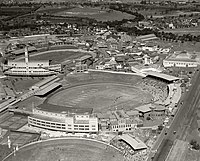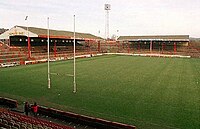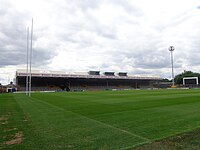The 1977 Rugby League World Cup was the eighth Rugby League World Cup tournament and was held in Australasia, with games played during May and June in both Australia and New Zealand. It featured four teams: Great Britain and France in addition to the two host nations. All teams played each other once, resulting in a top two of Great Britain and Australia who played in the tournament final at the Sydney Cricket Ground with the home team winning by one point.
The 1985–1988 Rugby League World Cup was the ninth Rugby League World Cup tournament held and saw yet another change of format with competition stretched to cover almost three years. The national rugby league teams of Australia, France, Great Britain, New Zealand and Papua New Guinea played each other on a home and away basis. These matches were fitted into the normal international programme of three-match test series between the nations, with a pre-designated match from each series counting as the world cup fixture. The tournament culminated in the 1988 Rugby League World Cup final.
The 1989–1992 Rugby League World Cup was the tenth staging of the Rugby League World Cup, and continued to use the three-year format, stretching across the years 1989 to 1992. As with the 1985–1988 World Cup, teams played each other on a home-and-away basis. These matches were fitted into the normal international programme of three-match test series between the nations, with a pre-designated match from each series counting as the World Cup fixture. The tournament culminated in the 1992 Rugby League World Cup final.

The 1995 Rugby League World Cup was held during October 1995 in the United Kingdom. It was the eleventh staging of the Rugby League World Cup and was marketed as the Halifax Centenary World Cup, reflecting the tournament's sponsorship and the fact that 1995 marked the centenary of the sport. Envisaged as a celebration of rugby league, the size of the competition was doubled, with four additional teams invited and England and Wales instead of Great Britain national rugby league team.

The Australia national rugby league team, the Kangaroos, have represented Australia in senior men's rugby league football competition since the establishment of the game in Australia in 1908. Administered by the Australian Rugby League Commission, the Kangaroos are ranked third in the IRL Men's World Rankings. The team is the most successful in Rugby League World Cup history, having won the competition 12 times, and contested 16 of the 17 finals, only failing to reach the final in the 1954 inaugural tournament. Only five nations have beaten Australia in test matches, and Australia has an overall win percentage of 69%.

The England national rugby league team represents England in international rugby league.

Paul Vautin nicknamed Fatty, is an Australian football commentator and formerly a professional rugby league footballer, captain and coach. He has provided commentary for the Nine Network's coverage of rugby league since joining the network in 1992 and also hosted The Footy Show from its beginnings in 1994 opposite co-host Peter Sterling, until 2017. An Australian Kangaroos test and Queensland State of Origin representative lock or second-row forward, Vautin played club football in Brisbane with Wests, before moving to Sydney in 1979 to play with Manly-Warringah, whom he would captain to the 1987 NSWRL premiership. He also played for Sydney's Eastern Suburbs, and in England for St Helens.

Peter Maxwell John Sterling nicknamed Sterlo, is an Australian former rugby league commentator, television personality and player. He was one of the all-time great halfbacks and a major contributor to Parramatta Eels' dominance of the New South Wales Rugby League premiership in the 1980s. Sterling played eighteen Tests for the Australian national team between 1982 and 1988. He also played in thirteen State of Origins for New South Wales, winning man of the match on four occasions. Sterling played in four premiership-winning sides with Parramatta in 1981–1983 and 1986 and has been inducted into the Australian Rugby League Hall of Fame. His time spent playing for English club Hull F.C. also earned him membership in their hall of fame.
PNG Football Stadium, known by the sponsored name of Santos National Football Stadium and previously as Lloyd Robson Oval until 2015, is a sporting ground in Port Moresby, Papua New Guinea. It hosted three games for the 1989–1992 Rugby League World Cup. It has been the home ground for the Papua New Guinea national rugby league team since 1975. It has a total capacity of approximately 15,000 and is the National Stadium of Papua New Guinea. The stadium was completely redeveloped in preparation for the 2015 Pacific Games.
Robert Fulton, also nicknamed "Bozo", was an Australian international rugby league footballer, coach and later commentator. Fulton played, coached, selected for and has commentated on the game with great success at the highest levels and has been named amongst Australia's greatest rugby league players of the 20th century. As a player Fulton won three premierships with the Manly-Warringah Sea Eagles in the 1970s, the last as captain. He represented the Australian national side on thirty-five occasions, seven times as captain. He had a long coaching career at the first grade level, taking Manly to premiership victory in 1987 and 1996. He coached the Australian national team in thirty-nine Tests. He was a New South Wales State selector and a national selector. He was a radio commentator with 2GB at the time of his death in 2021, aged 73. In 1981, he was selected as one of the initial four post-war "Immortals" of the Australian game and, in 2008, he was named in Australia's team of the century.
Graham "Wombat" Eadie, is an Australian former rugby league footballer who played in the 1970s and 1980s. He has been named amongst Australia's finest of the 20th century. A New South Wales State of Origin and Australian international representative fullback, he played in Australia during Manly-Warringah's dominance of the NSWRFL competition during the 1970s. He won four premierships with them and his 1,917 points in first grade and 2,070 points in all grades were both records at the time of his retirement. Eadie also played in England for Halifax, winning the Challenge Cup Final of 1987 with them. He also won World Cups with Australia and collected awards such as the Rothmans Medal and Lance Todd Trophy.
Michael William Cronin OAM is an Australian former professional rugby league footballer and coach. He was a goal-kicking centre for the Australian national team and a stalwart for the Parramatta Eels club. He played in 22 Tests and 11 World Cup matches between 1973 and 1982. Cronin retired as the NSWRL Premiership's and the Australian Kangaroos' all-time highest point-scorer and has since been named amongst the nation's finest footballers of the 20th century.
The 1980 State of Origin game was the first game between the Queensland Maroons and the New South Wales Blues rugby league teams to be played under "state of origin" selection rules. It was the third match of 1980's annual interstate series between the Blues and the Maroons, and was only allowed to go ahead because the first two matches were already won by New South Wales under established 'state of residency' rules. It was played on 8 July 1980 under the newly configured rules by which a player would represent his "state of origin", i.e. the state in which he was born or in which he started playing registered first grade rugby league football.
The 1986 New South Wales Rugby League premiership was the seventy-ninth season of professional rugby league football in Australia. Thirteen clubs competed for the J J Giltinan Shield and Winfield Cup during the season, which culminated in a grand final between the Parramatta Eels and Canterbury-Bankstown Bulldogs which featured the introduction of the Clive Churchill Medal. This season, NSWRL teams also competed for the 1986 National Panasonic Cup.

The 2017 Rugby League World Cup was the fifteenth staging of the Rugby League World Cup tournament and took place in Australia, New Zealand and Papua New Guinea between 27 October and 2 December 2017. The tournament featured the national teams of 14 Rugby League International Federation member countries who qualified through either standing in the previous tournament or a series of qualification play-off matches. In the final, defending champions Australia, playing in their 14th consecutive final, defeated England at Brisbane's Lang Park.
The 1991 Trans-Tasman Test series was an international rugby league test series played in Australia between Australia and New Zealand. The series, which started on 3 July in Melbourne and finished on 31 July in Brisbane, consisted of three test matches, with the third test doubling as a 1989–1992 Rugby League World Cup tournament match. New Zealand did not play in any other matches while on tour.
The 2013 Rugby League World Cup final was the conclusive game of the 2013 Rugby League World Cup tournament and was played between New Zealand and Australia on 30 November 2013 at Old Trafford, Manchester, England. Australia won the final by 34 points to 2 in front of a sell-out crowd, finishing the tournament undefeated. They reclaimed the cup from New Zealand, who had defeated them in the 2008 final. The Kangaroos won the Rugby League World Cup for the tenth time, and the first time since 2000. Their five-eighth, Johnathan Thurston was named man-of-the-match.
The 1978 Kangaroo tour of Great Britain and France comprised the Australia national rugby league team's fourteenth tour of Great Britain and ninth tour of France, and took place from September to December 1978. Coached by Frank Stanton and captained by Bob Fulton, the Australian team, also known as the Kangaroos, played a match against Wales before contesting the Ashes series against Great Britain, winning the third and deciding Test match. The tourists then moved on to France where they were narrowly beaten in both Tests, the last series the Kangaroos would lose until 2005. In addition to these six internationals, the Australians played sixteen other matches against local club and representative sides in both countries. The 1978 Kangaroo tour followed the tour of 1973 while the next tour would be staged in 1982.
The 1988 Rugby League World Cup final was the conclusive game of the 1985–1988 Rugby League World Cup tournament and was played between New Zealand and Australia on 9 October 1988 at Eden Park in Auckland, New Zealand. Australia won the final by 25 points to 12 in front of a New Zealand rugby league record attendance of 47,363. Australia, the defending champions, won the Rugby League World Cup for the 6th time.
The 1977 Rugby League World Cup final was the conclusive game of the 1977 Rugby League World Cup tournament and was played between Australia and Great Britain on 25 June 1977 at the Sydney Cricket Ground in Australia.




















